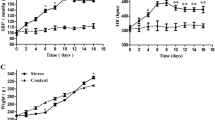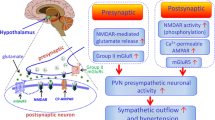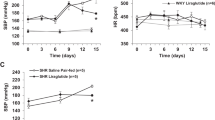Abstract
Long-term potentiation in sympathetic ganglia (gLTP) is similar to LTP of the hippocampal area CA1 in that its expression involves similar changes in signaling molecules. We have shown previously that the stress-prone, hypertensive obese Zucker rats (OZR) expressed gLTP in sympathetic ganglia and that high blood pressure was reduced by treatment with 5-HT3 receptor antagonists. In the present study, we present additional electrophysiological evidence for the pre-expression of gLTP in sympathetic ganglia from OZR indicated by failure of repetitive stimulation to express gLTP in isolated superior cervical ganglia (SCG) and inhibition of baseline ganglionic transmission by a 5-HT3 receptor antagonist. We have also investigated the role of key signaling molecules in the expression of gLTP in the hypertensive OZR. Immunoblot analysis showed a significant increase in the levels of phosphorylated (P-)CaMKII and protein kinase C gamma (PKCγ) in SCG from OZR. The ratio of P-CaMKII to the total CaMKII was markedly increased in OZR ganglia, suggesting increased phosphorylation of this molecule. Additionally, there was a significant decrease in the levels of calcineurin in ganglia. Furthermore, the neural nitric oxide synthase and hemeoxygenase II, which are essential for the expression of gLTP, were significantly elevated in OZR ganglia. The present findings confirm that ganglia from OZR have expressed gLTP and that synaptic plasticity in sympathetic ganglia may involve a molecular cascade similar to that of LTP of the brain hippocampal area CA1.







Similar content being viewed by others
References
Alkadhi, K. A., & Altememi, G. F. (1997). Nitric oxide mediates long-term potentiation in rat superior cervical ganglion. Brain Research, 753, 315–317. doi:10.1016/S0006-8993(97)00028-0.
Alkadhi, K. A., Alzoubi, K. H., & Aleisa, A. M. (2005a). Plasticity of synaptic transmission in autonomic ganglia. Progress in Neurobiology, 75, 83–108. doi:10.1016/j.pneurobio.2005.02.002.
Alkadhi, K. A., Alzoubi, K. H., Aleisa, A. M., Tanner, F. L., & Nimer, A. S. (2005b). Psychosocial stress-induced hypertension results from in vivo expression of long-term potentiation in rat sympathetic ganglia. Neurobiology of Disease, 20, 849–857. doi:10.1016/j.nbd.2005.05.020.
Alkadhi, K. A., Al-Hijailan, R. S., Malik, K., & Hogan, Y. H. (2001a). Retrograde carbon monoxide is required for induction of long-term potentiation in rat superior cervical ganglion. The Journal of Neuroscience, 21, 3515–3520.
Alkadhi, K. A., Otoom, S. A., Tanner, F. L., Sockwell, D., & Hogan, Y. H. (2001b). Inhibition of ganglionic long-term potentiation decreases blood pressure in spontaneously hypertensive rats. Experimental Biology and Medicine (Maywood, N.J.), 226, 1024–1030.
Alkadhi, K. A., Salgado-Commissariat, D., Hogan, Y. H., & Akpaudo, S. B. (1996). Induction and maintenance of ganglionic long-term potentiation require activation of 5-hydroxytryptamine (5-HT3) receptors. The Journal of Physiology, 496(Pt 2), 479–489.
Alonso-deFlorida, F., Morales, M. A., & Minzoni, A. A. (1991). Modulated long-term potentiation in the cat superior cervical ganglion in vivo. Brain Research, 544, 203–210. doi:10.1016/0006-8993(91)90055-Z.
Alonso-Galicia, M., Brands, M. W., Zappe, D. H., & Hall, J. E. (1996). Hypertension in obese Zucker rats. Role of angiotensin II and adrenergic activity. Hypertension, 28, 1047–1054.
Altememi, G. F., & Alkadhi, K. A. (1999). Nitric oxide is required for the maintenance but not initiation of ganglionic long-term potentiation. Neuroscience, 94, 897–902. doi:10.1016/S0306-4522(99)00362-0.
Alzoubi, K. H., Aleisa, A. M., & Alkadhi, K. A. (2008). Expression of gLTP in sympathetic ganglia from stree-hypertensive rats: Molecular evidence. Journal of Molecular Neuroscience, 35, 201–209
Alzoubi, K. H., Bedawi, A. S., Aleisa, A. M., & Alkadhi, K. A. (2004). Hypothyroidism impairs long-term potentiation in sympathetic ganglia: Electrophysiologic and molecular studies. Journal of Neuroscience Research, 78, 393–402. doi:10.1002/jnr.20268.
Arase, K., Shargill, N. S., & Bray, G. A. (1989). Effects of corticotropin releasing factor on genetically obese (fatty) rats. Physiology & Behavior, 45, 565–570. doi:10.1016/0031-9384(89)90074-7.
Bachoo, M., Heppner, T., Fiekers, J., & Polosa, C. (1992). A role for protein kinase C in long term potentiation of nicotinic transmission in the superior cervical ganglion of the rat. Brain Research, 585, 299–302. doi:10.1016/0006-8993(92)91223-2.
Bachoo, M., & Polosa, C. (1992). Preganglionic axons from the third thoracic spinal segment fail to induce long-term potentiation in the superior cervical ganglion of the cat. Canadian Journal of Physiology and Pharmacology, 70(Suppl), S27–S31.
Boone, J. L. (1991). Stress and hypertension. Primary Care, 18, 623–649.
Briggs, C. A., Brown, T. H., & McAfee, D. A. (1985). Neurophysiology and pharmacology of long-term potentiation in the rat sympathetic ganglion. The Journal of Physiology, 359, 503–521.
Briggs, C. A., & McAfee, D. A. (1988). Long-term potentiation at nicotinic synapses in the rat superior cervical ganglion. The Journal of Physiology, 404, 129–144.
Briggs, C. A., McAfee, D. A., & McCaman, R. E. (1988). Long-term regulation of synaptic acetylcholine release and nicotinic transmission: the role of cyclic AMP. British Journal of Pharmacology, 93, 399–411.
Brown, T. H., & McAfee, D. A. (1982). Long-term synaptic potentiation in the superior cervical ganglion. Science, 215, 1411–1413. doi:10.1126/science.6278593.
Carlson, S. H., Shelton, J., White, C. R., & Wyss, J. M. (2000). Elevated sympathetic activity contributes to hypertension and salt sensitivity in diabetic obese Zucker rats. Hypertension, 35, 403–408.
Cetiner, M., & Bennett, M. R. (1993). Nitric oxide modulation of calcium-activated potassium channels in postganglionic neurones of avian cultured ciliary ganglia. British Journal of Pharmacology, 110, 995–1002.
Clapham, J. C., & Turner, N. C. (1997). Effects of the glucocorticoid II receptor antagonist mifepristone on hypertension in the obese Zucker rat. The Journal of Pharmacology and Experimental Therapeutics, 282, 1503–1508.
Cunningham, J. J., Calles-Escandon, J., Garrido, F., Carr, D. B., & Bode, H. H. (1986). Hypercorticosteronuria and diminished pituitary responsiveness to corticotropin-releasing factor in obese Zucker rats. Endocrinology, 118, 98–101.
Dore, S., Takahashi, M., Ferris, C. D., Zakhary, R., Hester, L. D., Guastella, D., et al. (1999). Bilirubin, formed by activation of heme oxygenase-2, protects neurons against oxidative stress injury. Proceedings of the National Academy of Sciences of the United States of America, 96, 2445–2450. doi:10.1073/pnas.96.5.2445.
Dubois, E. A., Kam, K. L., Somsen, G. A., Boer, G. J., de Bruin, K., Batink, H. D., et al. (1996). Cardiac iodine-123 metaiodobenzylguanidine uptake in animals with diabetes mellitus and/or hypertension. European Journal of Nuclear Medicine, 23, 901–908. doi:10.1007/BF01084363.
Edwards, E., King, J. A., & Fray, J. (2000). Hypertension and insulin resistant models have divergent propensities to learned helpless behavior in rodents. American Journal of Hypertension, 13, 659–665. doi:10.1016/S0895-7061(99)00271-X.
Esler, M., Julius, S., Zweifler, A., Randall, O., Harburg, E., Gardiner, H., et al. (1977). Mild high-renin essential hypertension. Neurogenic human hypertension? The New England Journal of Medicine, 296, 405–411.
Fang, Z., Carlson, S. H., Peng, N., & Wyss, J. M. (2000). Circadian rhythm of plasma sodium is disrupted in spontaneously hypertensive rats fed a high-NaCl diet. American Journal of Physiology. Regulatory, Integrative and Comparative Physiology, 278, R1490–R1495.
Fukunaga, K., & Miyamoto, E. (2000). A working model of CaM kinase II activity in hippocampal long-term potentiation and memory. Neuroscience Research, 38, 3–17. doi:10.1016/S0168-0102(00)00139-5.
Fukunaga, K., Muller, D., & Miyamoto, E. (1996). CaM kinase II in long-term potentiation. Neurochemistry International, 28, 343–358. doi:10.1016/0197-0186(95)00097-6.
Gerges, N. Z., Aleisa, A. M., Alhaider, A. A., & Alkadhi, K. A. (2002). Reduction of elevated arterial blood pressure in obese Zucker rats by inhibition of ganglionic long-term potentiation. Neuropharmacology, 43, 1070–1076. doi:10.1016/S0028-3908(02)00283-6.
Gerges, N. Z., Aleisa, A. M., Schwarz, L. A., & Alkadhi, K. A. (2003). Chronic psychosocial stress decreases calcineurin in the dentate gyrus: a possible mechanism for preservation of early ltp. Neuroscience, 117, 869–874. doi:10.1016/S0306-4522(02)00766-2.
Gerges, N. Z., Aleisa, A. M., Schwarz, L. A., & Alkadhi, K. A. (2004). Reduced basal CaMKII levels in hippocampal CA1 region: possible cause of stress-induced impairment of LTP in chronically stressed rats. Hippocampus, 14, 402–410. doi:10.1002/hipo.10193.
Giese, K. P., Fedorov, N. B., Filipkowski, R. K., & Silva, A. J. (1998). Autophosphorylation at Thr286 of the alpha calcium-calmodulin kinase II in LTP and learning. Science, 279, 870–873. doi:10.1126/science.279.5352.870.
Hadjiconstantinou, M., Potter, P. E., & Neff, N. H. (1982). Trans-synaptic modulation via muscarinic receptors of serotonin-containing small intensely fluorescent cells of superior cervical ganglion. The Journal of Neuroscience, 2, 1836–1839.
Hogan, Y. H., Hawkins, R., & Alkadhi, K. A. (1998). Adenosine A1 receptor activation inhibits LTP in sympathetic ganglia. Brain Research, 807, 19–28. doi:10.1016/S0006-8993(98)00694-5.
Ikegaya, Y., Saito, H., & Matsuki, N. (1994). Involvement of carbon monoxide in long-term potentiation in the dentate gyrus of anesthetized rats. Japanese Journal of Pharmacology, 64, 225–227. doi:10.1254/jjp.64.225.
Kandel, E. R., & Hawkins, R. D. (1992). The biological basis of learning and individuality. Scientific American, 267, 78–86.
Kasiske, B. L., O’Donnell, M. P., & Keane, W. F. (1992). The Zucker rat model of obesity, insulin resistance, hyperlipidemia, and renal injury. Hypertension, 19, I110–I115.
Kurtz, T. W., Morris, R. C., & Pershadsingh, H. A. (1989). The Zucker fatty rat as a genetic model of obesity and hypertension. Hypertension, 13, 896–901.
Landsberg, L., & Young, J. B. (1985). Insulin-mediated glucose metabolism in the relationship between dietary intake and sympathetic nervous system activity. International Journal of Obesity, 9(Suppl 2), 63–68.
Lin, Y. Q., & Bennett, M. R. (1994). Nitric oxide modulation of quantal secretion in chick ciliary ganglia. The Journal of Physiology, 481(Pt 2), 385–394.
Lledo, P. M., Hjelmstad, G. O., Mukherji, S., Soderling, T. R., Malenka, R. C., & Nicoll, R. A. (1995). Calcium/calmodulin-dependent kinase II and long-term potentiation enhance synaptic transmission by the same mechanism. Proceedings of the National Academy of Sciences of the United States of America, 92, 11175–11179. doi:10.1073/pnas.92.24.11175.
Macor, J. E., Gurley, D., Lanthorn, T., Loch, J., Mack, R. A., Mullen, G., et al. (2001). The 5-HT3 antagonist tropisetron (ICS 205-930) is a potent and selective alpha7 nicotinic receptor partial agonist. Bioorganic and Medicinal Chemistry Letters, 11, 319–321.
Malenka, R. C., Kauer, J. A., Perkel, D. J., Mauk, M. D., Kelly, P. T., Nicoll, R. A., et al. (1989). An essential role for postsynaptic calmodulin and protein kinase activity in long-term potentiation. Nature, 340, 554–557. doi:10.1038/340554a0.
Marwaha, A., Banday, A. A., & Lokhandwala, M. F. (2004). Reduced renal dopamine D1 receptor function in streptozotocin-induced diabetic rats. American Journal of Physiology. Renal Physiology, 286, F451–457.
Maurice, D. H., & Haslam, R. J. (1990). Molecular basis of the synergistic inhibition of platelet function by nitrovasodilators and activators of adenylate cyclase: Inhibition of cyclic AMP breakdown by cyclic GMP. Molecular Pharmacology, 37, 671–681.
McEwen, B. S. (1998). Protective and damaging effects of stress mediators. The New England Journal of Medicine, 338, 171–179. doi:10.1056/NEJM199801153380307.
Medina, J. H., & Izquierdo, I. (1995). Retrograde messengers, long-term potentiation and memory Brain Research. Brain Research Reviews, 21, 185–194.
Minota, S., Kumamoto, E., Kitakoga, O., & Kuba, K. (1991). Long-term potentiation induced by a sustained rise in the intraterminal Ca2+ in bull-frog sympathetic ganglia. The Journal of Physiology, 435, 421–438.
Morgan, D. A., Anderson, E. A., & Mark, A. L. (1995). Renal sympathetic nerve activity is increased in obese Zucker rats. Hypertension, 25, 834–838.
Nichols, R. A., & Mollard, P. (1996). Direct observation of serotonin 5-HT3 receptor-induced increases in calcium levels in individual brain nerve terminals. Journal of Neurochemistry, 67, 581–592.
Pacak, K., Palkovits, M., Makino, S., Kopin, I. J., & Goldstein, D. S. (1996). Brainstem hemisection decreases corticotropin-releasing hormone mRNA in the paraventricular nucleus but not in the central amygdaloid nucleus. Journal of Neuroendocrinology, 8, 543–551. doi:10.1046/j.1365-2826.1996.04888.x.
Pamidimukkala, J., & Jandhyala, B. S. (1996). Evaluation of hemodynamics, vascular reactivity and baroreceptor compensation in the insulin resistant Zucker obese rats. Clin Exp Hypertens, 18, 1089–1104. doi:10.3109/10641969609081036.
Papke, R. L., Porter Papke, J. K., & Rose, G. M. (2004). Activity of alpha7-selective agonists at nicotinic and serotonin 5HT3 receptors expressed in Xenopus oocytes. Bioorganic and Medicinal Chemistry Letters, 14, 1849–1853.
Papke, R. L., Schiff, H. C., Jack, B. A., & Horenstein, N. A. (2005). Molecular dissection of tropisetron, an alpha7 nicotinic acetylcholine receptor-selective partial agonist. Neuroscience Letters, 378, 140–144.
Pettit, D. L., Perlman, S., & Malinow, R. (1994). Potentiated transmission and prevention of further LTP by increased CaMKII activity in postsynaptic hippocampal slice neurons. Science, 266, 1881–1885. doi:10.1126/science.7997883.
Poss, K. D., Thomas, M. J., Ebralidze, A. K., O’Dell, T. J., & Tonegawa, S. (1995). Hippocampal long-term potentiation is normal in heme oxygenase-2 mutant mice. Neuron, 15, 867–873. doi:10.1016/0896-6273(95)90177-9.
Reaven, G. M., Lithell, H., & Landsberg, L. (1996). Hypertension and associated metabolic abnormalities—The role of insulin resistance and the sympathoadrenal system. The New England Journal of Medicine, 334, 374–381. doi:10.1056/NEJM199602083340607.
Roberts, L. A., Large, C. H., Higgins, M. J., Stone, T. W., O’Shaughnessy, C. T., & Morris, B. J. (1998). Increased expression of dendritic mRNA following the induction of long-term potentiation. Brain Research. Molecular Brain Research, 56, 38–44. doi:10.1016/S0169-328X(98)00026-6.
Scott, T. R., & Bennett, M. R. (1993). The effect of nitric oxide on the efficacy of synaptic transmission through the chick ciliary ganglion. British Journal of Pharmacology, 110, 627–632.
Schuman, E. M., & Madison, D. V. (1994). Locally distributed synaptic potentiation in the hippocampus. Science, 263, 532–536.
Sheng, H., Gagne, G. D., Matsumoto, T., Miller, M. F., Forstermann, U., & Murad, F. (1993). Nitric oxide synthase in bovine superior cervical ganglion. Journal of Neurochemistry, 61, 1120–1126. doi:10.1111/j.1471-4159.1993.tb03628.x.
Siegrist, J. (2001). Psychosocial factors influencing development and course of coronary heart disease. Herz, 26, 316–325. doi:10.1007/PL00002036.
Stevens, C. F., & Wang, Y. (1993). Reversal of long-term potentiation by inhibitors of haem oxygenase. Nature, 364, 147–149. doi:10.1038/364147a0.
Suter, P. M., Maire, R., Holtz, D., & Vetter, W. (1997). Relationship between self-perceived stress and blood pressure. Journal of Human Hypertension, 11, 171–176. doi:10.1038/sj.jhh.1000409.
Thomas, K. L., Laroche, S., Errington, M. L., Bliss, T. V., & Hunt, S. P. (1994). Spatial and temporal changes in signal transduction pathways during LTP. Neuron, 13, 737–745. doi:10.1016/0896-6273(94)90040-X.
Tonello, C., Giordano, A., Cozzi, V., Cinti, S., Stock, M. J., Carruba, M. O., et al. (1999). Role of sympathetic activity in controlling the expression of vascular endothelial growth factor in brown fat cells of lean and genetically obese rats. FEBS Letters, 442, 167–172. doi:10.1016/S0014-5793(98)01627-5.
Turner, N. C., Gudgeon, C., & Toseland, N. (1995). Effects of genetic hyperinsulinaemia on vascular reactivity, blood pressure, and renal structure in the Zucker rat. Journal of Cardiovascular Pharmacology, 26, 714–720. doi:10.1097/00005344-199511000-00007.
Van Zwieten, P. A., Kam, K. L., Pijl, A. J., Hendriks, M. G., Beenen, O. H., & Pfaffendorf, M. (1996). Hypertensive diabetic rats in pharmacological studies. Pharmacological Research, 33, 95–105. doi:10.1006/phrs.1996.0015.
Walker, B. R., & Edwards, C. R. (1994). New mechanisms for corticosteroid-induced hypertension. British Medical Bulletin, 50, 342–355.
Walker, C. D., Scribner, K. A., Stern, J. S., & Dallman, M. F. (1992). Obese Zucker (fa/fa) rats exhibit normal target sensitivity to corticosterone and increased drive to adrenocorticotropin during the diurnal trough. Endocrinology, 131, 2629–2637. doi:10.1210/en.131.6.2629.
Wang, J. H., & Kelly, P. T. (1996). The balance between postsynaptic Ca(2+)-dependent protein kinase and phosphatase activities controlling synaptic strength. Learning & Memory (Cold Spring Harbor, N.Y.), 3, 170–181. doi:10.1101/lm.3.2-3.170.
Zhuo, M., Small, S. A., Kandel, E. R., & Hawkins, R. D. (1993). Nitric oxide and carbon monoxide produce activity-dependent long-term synaptic enhancement in hippocampus. Science, 260, 1946–1950. doi:10.1126/science.8100368.
Acknowledgment
Support is contributed by a grant (0255402Y) from AHA-Texas Affiliate.
Author information
Authors and Affiliations
Corresponding author
Rights and permissions
About this article
Cite this article
Alzoubi, K.H., Aleisa, A.M. & Alkadhi, K.A. Expression of gLTP in Sympathetic Ganglia of Obese Zucker Rats In Vivo: Molecular Evidence. J Mol Neurosci 35, 297–306 (2008). https://doi.org/10.1007/s12031-008-9110-6
Received:
Accepted:
Published:
Issue Date:
DOI: https://doi.org/10.1007/s12031-008-9110-6




